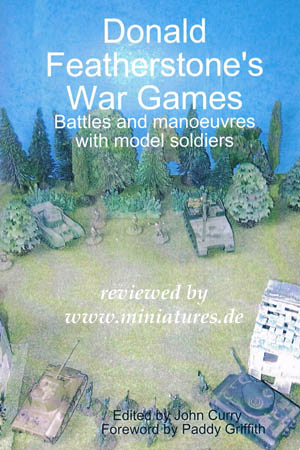Donald Featherstone’s War Games
Battles and Manœuvres with Model Soldiers

For centuries, battles with model soldiers have been fought by Kings and Generals for military purposes, and for pleasure by boys from nine to ninety years of age. The model soldier possesses unlimited courage on the war games table and, ably led by an amateur general with a realistic set of rules, he can win great victories or be magnificent in defeat.
As a means of military training, war games have long ago proved their worth, but it is as a form of skillful relaxation that the subject is considered in this book. Grand strategy can be practised on maps, complicated tactical manœuvres attempted on the realistic table-top battlefield, and colourful armies of miniature soldiers can be made to fire accurately, attack forcibly in flank or rear and hold out grimly against vastly superior numbers.
Sometimes called “Chess with a Thousand Pieces”, war games can be simple affairs played on the dining room table with a handful of soldiers, or highly complicated battles involving two thousand or more troops fighting to realistic rules on large tables with hills, valleys, rivers, woods, villages, even towns with streets, factories and stations.
The book contains three sets of classic rules:
- Tony Bath’s first Ancient Wargaming Rules
- Donald Featherstone’s own American Civil Wargaming Rules
- Lionel Tarr’s World War II Wargaming Rules
Contents
- Title: Donald Featherstone’s War Games
- Period: Ancients to WW2
- Type: Tactical Wargame
- Time Scale: 1 turn = 1 hour
- Ground Scale: 1 inch on the map = 12 inches on the table-top
- Troop Scale: 15 to 30 figures per regiment
- Author: Donald Featherstone, Tony Bath, Lionel Tarr
- Format: 156-page rule book
- Language: English
- Publisher: John Curry
- Published: 1962 (revised in 2008)
Chapters
Introduction to Don Featherstone’s War Games by Paddy Griffith
Original Forward by Brigadier Peter Young
Preface by Donald Featherstone
- What are War Games?
- Model Soldiers for War Games
- How to Lay Out a Battlefield
- Organizing a Campaign
- How to Start a War Game
- Ancient Warfare
- Horse-and-Musket Warfare
- Modern Warfare Tank and Infantry Action on the St. James Road
- Solo War Games
Appendix 1 Rules for “Close War”
Appendix 2 The Lionel Tarr Periscope
Appendix 3 Timeline of the History of Wargaming
Old School Rules for Ancients to World-War Two Wargaming
Donald Featherstone’s classic book contains the rules for three popular periods of warfare, from ancient times, through the 18th and 19th century horse-and-musket period, to World-War Two. Model soldiers are moved individually, and deployed in regiments of 15 to 30 figures each. In the modern period of warfare, 10 figures represent an infantry company which may operate independently of the other companies in the regiment. In earlier periods, the model soldiers of the regiment move and fight in the same formation.
The rules are considered "old school" by today’s standards. Six-sided dice are used throughout the game, and the rules are easy enough to remember without constant reference to the manual or a quick reference chart. Players are encouraged to amend these rules and add house rules where certain aspects of warfare have not been covered in the book.
The authors offer sound advice on creating campaign maps and running small campaigns which provide the strategic background for individual table-top battles. Supply and logistics, casualty evacuation, replacements and recruiting can be handled by simple game mechanisms which require minimal bookkeeping even without the assistance of a personal computer.